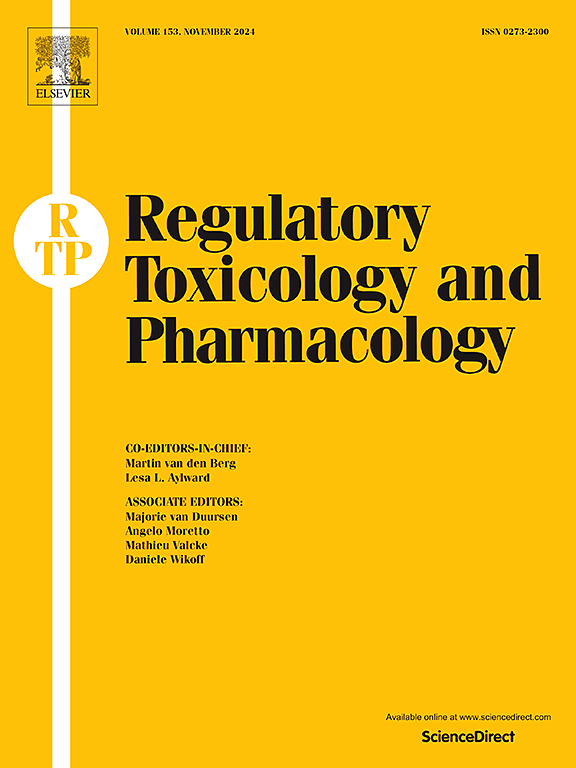Utilizing metabolism-based structure-activity relationships and biokinetic modeling for toxicological evaluation: A case study on L-menthyl D-Lactate
IF 3.5
4区 医学
Q1 MEDICINE, LEGAL
引用次数: 0
Abstract
Structure activity relationship (SAR) based read across uses existing toxicity data from an analog to predict the toxicity of a target chemical. An analog can be classified as suitable, suitable with interpretation, suitable with precondition or not suitable. Few have evaluated the scenario of “suitable with precondition”; thus, we present a case study where the systemic safety of L-menthyl D-lactate is established via suitable with precondition analogs, DL-menthol and D-lactic acid, which are predicted ester hydrolysis metabolites of the target chemical. In vitro metabolism assays demonstrated the ester hydrolysis pathway for L-menthyl D-lactate, indicating that the ester hydrolysis metabolites could be used as analogs. The rate and extent of L-menthyl D-lactate metabolism by human skin and liver S9 and plasma were determined and inputted into a human physiologically based pharmacokinetic (PBPK) model to estimate internal exposure to L-menthyl D-lactate following different exposure scenarios. Margins of internal and external exposure were determined by comparing scenario specific exposures to an internal threshold of toxicological concern or toxicity data from the metabolites. Additional analysis conducted with a rat PBPK model to prospectively estimate internal exposure to L-menthyl D-lactate that would occur from an oral toxicity study demonstrated that it would be metabolized rapidly and extensively by rats and the predominate (99.8 %) systemic exposure would be to the ester hydrolysis metabolites with only a minor, transient exposure occurring to L-menthyl D-lactate. Reapplication of the current approach for human safety assessments holds promise for ensuring human health by using robust approaches for read across.
利用基于代谢的构效关系和生物动力学模型进行毒理学评价:以l -乳酸薄荷酯为例。
基于结构活性关系(SAR)的交叉读取利用现有的类似物毒性数据来预测目标化学品的毒性。模拟可以分为适合、适合解释、适合前置和不适合。很少有人对“有先决条件的适宜”方案进行评估;因此,我们提出了一个案例研究,通过合适的前置类似物,dl -薄荷醇和d -乳酸来建立l -薄荷基d -乳酸的全身安全性,它们是目标化学物质的预测酯水解代谢产物。体外代谢实验证实了l -薄荷基d -乳酸酯的酯水解途径,表明酯水解代谢产物可作为类似物。测定人体皮肤、肝脏S9和血浆对l -薄荷基d -乳酸代谢的速率和程度,并将其输入人体生理药代动力学(PBPK)模型,以估计不同暴露情景下l -薄荷基d -乳酸的内暴露。通过比较特定情景暴露与毒理学关注的内部阈值或代谢物的毒性数据来确定内部和外部暴露的边缘。通过对大鼠PBPK模型的进一步分析,对口服毒性研究中可能发生的l -薄荷基d -乳酸的内暴露进行了前瞻性评估,结果表明,大鼠对l -薄荷基d -乳酸的代谢迅速而广泛,主要(99.8%)的全身暴露是酯水解代谢物,只有少量的短暂暴露于l -薄荷基d -乳酸。重新应用目前的人类安全评估方法有望通过使用可靠的方法来确保人类健康。
本文章由计算机程序翻译,如有差异,请以英文原文为准。
求助全文
约1分钟内获得全文
求助全文
来源期刊
CiteScore
6.70
自引率
8.80%
发文量
147
审稿时长
58 days
期刊介绍:
Regulatory Toxicology and Pharmacology publishes peer reviewed articles that involve the generation, evaluation, and interpretation of experimental animal and human data that are of direct importance and relevance for regulatory authorities with respect to toxicological and pharmacological regulations in society. All peer-reviewed articles that are published should be devoted to improve the protection of human health and environment. Reviews and discussions are welcomed that address legal and/or regulatory decisions with respect to risk assessment and management of toxicological and pharmacological compounds on a scientific basis. It addresses an international readership of scientists, risk assessors and managers, and other professionals active in the field of human and environmental health.
Types of peer-reviewed articles published:
-Original research articles of relevance for regulatory aspects covering aspects including, but not limited to:
1.Factors influencing human sensitivity
2.Exposure science related to risk assessment
3.Alternative toxicological test methods
4.Frameworks for evaluation and integration of data in regulatory evaluations
5.Harmonization across regulatory agencies
6.Read-across methods and evaluations
-Contemporary Reviews on policy related Research issues
-Letters to the Editor
-Guest Editorials (by Invitation)

 求助内容:
求助内容: 应助结果提醒方式:
应助结果提醒方式:


